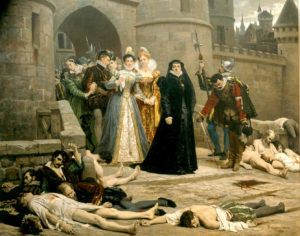1572 The St Bartholomew’s Day Massacre
Calvinist Protestantism had been very successful in converting many Frenchmen in the middle of the sixteenth century, particularly among the middle class and nobility. Attempts to outlaw the sect or repress it militarily had led to civil war. In 1572 the country was divided amongst Calvinists, ultra-Catholics, and the party of moderate Catholics led by the royal family. Catherine de Medici, the Queen Mother, had arranged a marriage between her daughter Margot (or Marguerite) and the leading young Protestant, Henry of Navarre, a union which was meant to cement a religious peace. The wedding was to take place on August 18th and to Paris came all the leading Calvinists: their military leaders, clerics, nobility and intellectuals.
Opposing the marriage was the hard-line Catholic (and cousin to the royal family), Henry, Duke of Guise, who blamed the Protestants, and especially their military chief Admiral Gaspard de Coligny, for the death in battle of his father. Guise convinced the weak-minded young king Charles IX that the religious stand-off in France could be solved by decapitating the Protestant party. All their leaders were in the capital; simply lock the gates, rid the city of its heretics and France would be whole again. So, on August 22 an assassination attempt was made on Coligny’s life; he was hit by a bullet and seriously wounded, but survived. The next night the Queen Mother (seen below viewing the results of her policy) met with her Council and gave the order. The church bells rang to signal the attack. Led by the Swiss Guards, armed men seized and murdered Coligny (pictured above) and most of the Protestant nobility; Catholic inhabitants of Paris seized the moment to conduct a general massacre of their heretic neighbours. The bridegroom, Henry of Navarre, was spared on condition he convert to Catholicism. The atrocities continued for several days and spread to the French provinces. Tens of thousands were murdered; Pope Gregory XIII exulted at the slaughter which he equated with the defeat of the Turkish fleet at Lepanto the year before.
Naturally, the French religious civil war was reignited and peace came to Paris only decades later when Henry of Navarre, who had escaped and converted back to Protestantism, converted once again Catholicism and became Henry IV.

